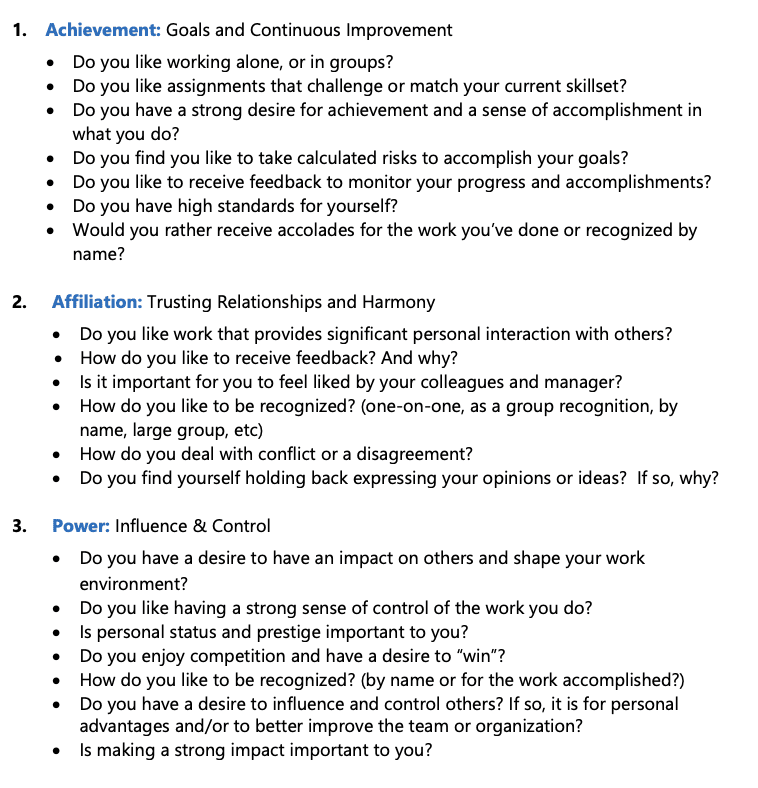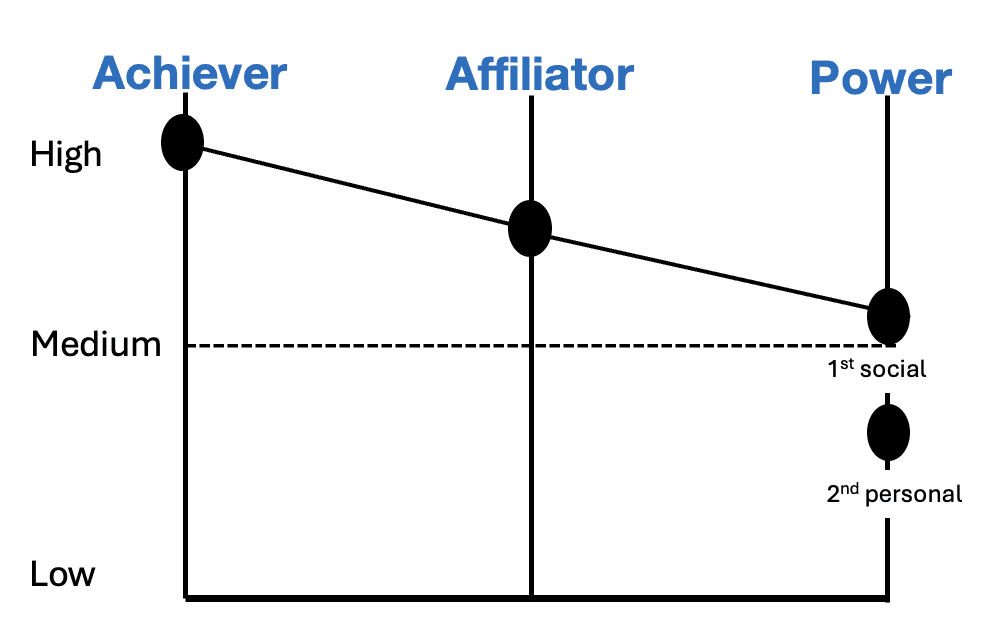Motivation is defined as, “the general desire or willingness of someone to do something.” It’s the force that drives us to perform, advance, and ultimately succeed. Motivation may come easy for some, but for others it takes conscious effort. This does not reflect laziness or a lack of ambition, but rather the importance of recognizing the internal and external factors that can either advance or impede our motivation levels. By identifying what truly motivates us, we gain insights on how to maintain our own engagement and satisfaction with our work. As leaders, understanding these motivators also enables us to effectively inspire and motivate our teams.
English author and motivational speaker Marcus Buckingham says that great managers “play chess rather than checkers.” As we know, in checkers, all the pieces are the same. They’re interchangeable, sharing the same properties, actions, and value. In chess, each piece has their own unique importance, abilities, and purpose. You need to understand how each piece moves and incorporate this knowledge into your method to win the game of chess. Buckingham suggests that leaders should take a similar approach to management, focusing on understanding the unique attributes of each employee and what makes them tick, nurturing employees’ strengths, capabilities, and motivators. Taking the time to understand how to meet the unique needs of each team member is a key way to ensure that everyone is engaged and has access to the resources they need to excel.
There’s a story from “Getting to Yes: Negotiating an Agreement Without Giving In: The Secret to Successful Negotiation” by Roger Fischer about an orange and two children. I modify this story in my training facilitations to illustrate a scenario where a mother is faced with a dilemma. In the story, there are two children and only one orange; both children want the orange. The mom goes through a series of options that don’t achieve the best outcome, until she became curious and asks a question. When she asked a question to understand the needs behind the desire for the orange, it turned out one child wanted to eat the orange and the other child wanted the orange rind for a science project at school. The takeaway here is to be curious and take the time to uncover the needs of your employees, what motivates each of them, and how to move forward to achieve the best outcomes.
Back in the 1970s and 1980s, psychologists Edward L. Deci and Richard M. Ryan began developing The Self-Determination Theory (SDT) of motivation, which was first formally introduced in their 1985 book, “Self-Determination and Intrinsic Motivation in Human Behavior.” This theory suggests people are best driven by internal (intrinsic) motivators as opposed to external (extrinsic) motivators. When someone has intrinsic motivation to do something, they feel motivated by an aspect of the task itself. Alternatively, when someone has extrinsic motivation, they are motivated by the reward they receive in return. For example, taking on a new task because you want to learn something new would be considered intrinsic, as opposed to the extrinsic motivation of potential accolades or promotions you may receive in return. There’s nothing wrong with having extrinsic motivation, but without intrinsic motivation, these tasks and activities tend to become less satisfying and fulfilling over time. The sense of gratification and lasting fulfillment that comes from intrinsic motivation often surpasses the quick and fleeting rewards associated with extrinsic motivation. The goal is to find a true purpose to your work, whether it’s knowledge, growth, or any other aspects that contribute to your own development as a person as well as a professional.
Our motivational drivers are developed throughout our lives based off our experiences. Many needs-based theories of motivation have been developed to help us better understand what drives us and those around us. Some earlier examples include Maslow’s Hierarchy of Needs, Alderfer’s ERG theory, and more recently Daniel Pink’s autonomy, purpose, and mastery model. However, I find myself reverting to the work of the well-known motivational model called the “Three Needs Theory” developed by David McClelland. This model details three primary motivational needs: 1) achievement, 2) affiliation, and 3) power (social and personal). Everyone is motivated by each of these three needs, but one or two will be dominant over the others.
Some research suggests that our motivational patterns are largely shaped during the pivotal ages of 10-13 years old, often influenced by the fears, anxieties, and concerns experienced during this developmental period. Referred to as one of the most dynamic phases in our lifetime, second only to infancy in terms of rapid growth, this time encompasses intense physical and mental changes. Unmet needs during this period can give rise to fears, insecurities, and concerns, such as:
1. Not feeling smart or competent enough
2. Lacking a sense of being liked, loved, or accepted
3. Experiencing a loss of control or powerlessness
These formative experiences can significantly impact our motivations and behaviors, shaping our ongoing drive for achievement, acceptance, and a sense of control in various aspects of life as an adult.
Take a look at the below descriptors of the 3 motivational needs and see what resonates with you the most. If you had to prioritize them, what would come first, second, and third?
Achievement (nAch)
Those who have a dominant need for achievement are most motivated by accomplishment and a need to excel. They don’t compete against others as much as compete with themselves, always wanting to find ways to become better. In the workplace, this can look like seeking challenging work, setting high expectations, and reaching high performance. Typically, these individuals tend to prefer either working alone or with like-minded peers. Achievers may pass off tasks that are too easy yet avoid tasks that are too difficult to prevent potential failure. Regular feedback is essential for achievers, as it helps them monitor their progress, receive recognition for their achievements, and identify areas for further improvement. To effectively motivate achievers, providing specific feedback that acknowledges their work output and highlights how it contributes value to the team or organization is crucial. Generalized feedback, such as “great job” without additional detail, can be seen as empty praise. By offering targeted feedback, leaders have a better chance of genuinely motivating achievers for continued success.
The key need is “Goals and Continuous Improvement.”
Affiliation (nAff)
Individuals with a dominant need for affiliation find motivation in social relationships, placing high value on acceptance and being part of a team. They thrive in collaborative settings and derive motivation from connecting with others. Positions that involve team collaboration and frequent social interactions, such as meetings and group projects, are particularly well-suited for individuals driven by affiliation. When it comes to recognition, those with an affiliation-driven mindset prefer to be acknowledged as part of a collective rather than being singled out. This preference stems from their need to feel accepted and liked, as they prioritize maintaining positive relationships and avoiding potential impact on those connections that may arise from being singled out for recognition.
The key need is “Trusting Relationships and Harmony.”
Power (nPow)
Individuals driven by a need for power derive their motivation from exerting influence over others and possessing a sense of control. They thrive in roles where they can take the lead, manage teams, and work on impactful projects. Clarity in expectations and a clear path for career advancement are often essential for those motivated by power.
These individuals naturally gravitate towards leadership positions, as they possess a strong inclination to take charge in group dynamics. When it comes to feedback, individuals with a need for power often appreciate recognition based on their title and position rather than solely on the work they perform. They prefer to be recognized in front of others (e.g. team meeting or small to large audiences) and also through publications, social media, or other means that highlight their influence and control over outcomes. Individuals driven by a need for power have the potential to utilize their attributes such as wealth, resources, relationships, or expertise for personal success or for the benefit of their team and organization. Often, these individuals have a dual need for both personal achievement and collective advancement, although one usually exceeds the other in terms of need.
The key need is “Influence & Control” whether on a social/organizational and/or personal level.
As a leader, what can you do to help uncover your employees’ motivational needs and play “chess” not checkers?”
The #1 way to do this is to schedule consistent one-on-one meetings with each team member that fosters open, two-way dialogue.
Review the below questions and ask your employees a few from each of the 3 motivational drivers to better understand what your employees need and how you can best support them.

One way you can plot your own motivational pattern is by drawing the below grid and plotting from low to high the needs you have for each of the three motivational drivers. Then, connect the dots. If you were to ask me some of these questions, here is how I would show up:

My motivation primarily stems from setting and achieving goals, as well as a strong drive for continuous improvement. I am constantly seeking ways to enhance my skills and strive for excellence. Additionally, building trusting and harmonious relationships is very important to me, as I deeply value creating long lasting relationships and a positive and supportive environment. Lastly, I also have a need for a certain level of control, which is mainly expressed through utilizing my strengths and abilities to serve others. However, I also appreciate having some personal control over my own endeavors and recognition of my accomplishments. It is important to note, this is a self-assessment, and only you know what your needs are to feel most motivated. There are no right or wrong, good or bad motivational patterns.
What would your motivational pattern look like?
By investing time in understanding the motivation patterns of each individual on your team, you gain valuable and necessary insights that will directly impact their motivation and engagement, leading to optimal performance. This targeted approach allows you to focus your attention on the areas that truly matter, demonstrating your genuine care for their individual needs. In doing so, aligning everyone’s efforts towards achieving collective success, metaphorically speaking, like a winning in the game of chess.
